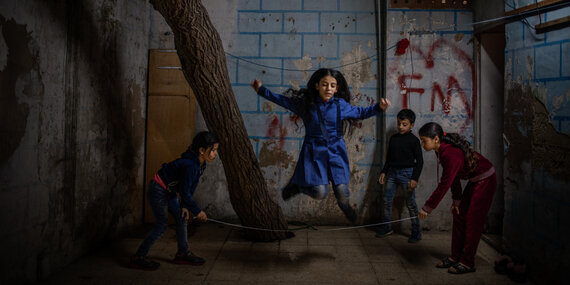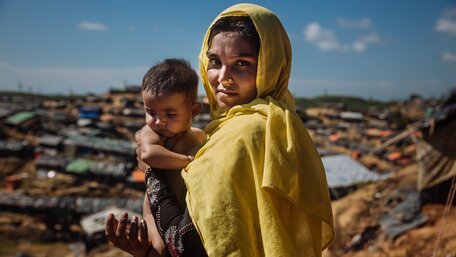Amman, Jordan
For this 11-year-old girl, a refugee from Homs living in Jordan, the war has compelled her to take on responsibilities well beyond her years. Her mother said: “She is only 11, but she’s living the life of a 30-year-old woman.” The girl explained: “It’s because of our situation. I have to support my parents and my brothers. They don’t have anyone else but me.” Her mother earns 5 Jordanian dinars ($7) for half-days spent cleaning houses, but her father cannot work or look after her siblings due to the lingering physical and psychological effects of his experiences in Syria. This leaves the girl to take on many of the household chores. UNHCR/Diego Ibarra
In 2022, UNHCR and partners will continue to develop Regional Refugee Response Plans (RRPs) which respond to refugee crises in situations of sudden-onset emergencies and to more protracted circumstances. This will include the RRPs for Afghanistan, the Democratic Republic of the Congo (DRC) and South Sudan. In addition, UNHCR and UNDP will continue to co-lead the Regional Refugee and Resilience Plan in response to the Syria crisis (3RP).
Regional Refugee Response Plans
The RRPs aim to support the efforts of host-governments to address the needs of refugees as well as host communities impacted by crises. The focus will remain on ensuring protection and promoting solutions through multisectoral response activities, supporting the objectives stated in the 2016 New York Declaration for Refugees and Migrants, and ensuring appropriate linkages with the Global Compact on Refugees (GCR).
Many interventions are humanitarian in nature. However, in 2022 stronger linkages with development partners and, where relevant, peace actors are encouraged to ensure progress towards the Sustainable Development Goals (SDGs) and the pledge of Leaving No One Behind. A strong focus on accountability and the empowerment of refugees as well as localization will be key to the successful implementation of these plans.
Regional Refugee Appeals
Adopting a 'whole-of-society' approach, the 2022 RRPs will be implemented in close collaboration with a wide range of partners, including UN agencies, other international and national organizations, civil-society actors as well as local organizations, many of which are refugee- and women-led, as well as faith-based organizations.
Increased and enhanced partnerships with development and financial institutions and the private sector will continue to be perused. This will enable response to immediate needs whilst initiating longer-term solutions and addressing the root causes of crises. Emphasis will be placed on delivering comprehensive responses that combine humanitarian and development activities. In the same vein and considering the dual impact on refugees and host communities, efforts will be made to complement and support existing sectoral, regional and national planning instruments, contributing collectively to the implementation of the 2030 Agenda and the SDGs.
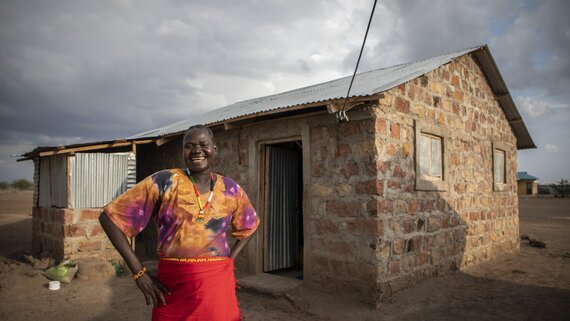
Kalobeyei, Kenya
A refugee from Lotuko, South Sudan, stands outside her newly constructed home in the Kalobeyei settlement. She came to Kakuma in 2016 and lived in a tent for two years before building a permanent home for her extended family through the Cash for Shelter project.
UNHCR/Will SwansonThe 2022 RRPs will also continue to integrate new health and socioeconomic needs that have been caused by the COVID-19 pandemic - namely for situations where underlying vulnerabilities were already exacerbated by conflict and violence. Programming is made through an integrated age, gender and diversity (AGD) mainstreaming approach, ensuring particular focus on people with disabilities or other specific needs.
Several cross-cutting priorities are included in the 2022 RRPs. A greater understanding of the dynamics of climate change on displacement will help partners to upscale environmental mainstreaming. Where possible and appropriate, they will also strive to ensure protection of displaced people who are exposed to natural disasters and to promote environmental sustainability. Measures to prevent, mitigate and respond to the risks of sexual exploitation and abuse as well as sexual harassment will be prioritized and integrated in all sector programmes within the 2022 plans. Activities to strengthen the empowerment of communities and accountability towards affected populations are core elements of the plans.
Afghanistan Regional
Analysis of the context, crisis and needs
Afghanistan’s neighbouring countries, particularly the Islamic Republic of Iran and the Islamic Republic of Pakistan, host more than 2.2 million registered refugees from previous waves of forced displacement, and a further 4 million Afghans of varying statuses. This has stretched the capacity of host communities. The majority of Afghans in both countries reside in urban and peri-urban areas, relying on national public services that are largely available to them. Despite their own challenges and their populations’ needs, Iran and Pakistan have upheld their international protection obligations for decades and pursued inclusive policies, notably in areas of education, health care and human capital development. However, the difficult economic situation in these and other neighbouring countries, exacerbated by the COVID-19 pandemic and a growing asylum fatigue in some host communities, is creating further challenges for the host governments to continue their policy of inclusion of Afghans in national systems.
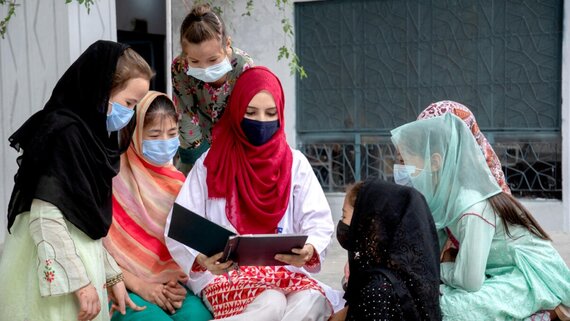
Attock, Pakistan
Two decades ago, this Afghan refugee, Saleema, was one of only a handful of refugee girls attending classes at the Barakat Primary School in Attock, west of Pakistan’s capital, Islamabad. Now, age 29, Saleema is speaking to a class of about 30 young refugee girls at her old school, wearing a doctor’s coat. “As a child, I was not aware of my refugee status,” she said. “But I came to know about it when my classmates were getting admitted to colleges of higher education, and I was not because I’m a refugee.” Today, Saleema’s story and work are bringing change. Some of the staunchest opponents of girls’ education in her community call her to seek health advice for their wives, sisters and daughters. Many now send their daughters to school in the hope that they might follow in Saleema’s footsteps.
UNHCR/Amsal NaeemThis further highlights the need for programmes aimed at fostering coexistence and alleviating the burden on host communities. In addition, humanitarian programmes to support the existing Afghan populations in the region have been critically underfunded in recent years. In parts of Central Asia, COVID-19 has already triggered unprecedented health, humanitarian and socioeconomic crises, and a refugee influx may further stretch the already overwhelmed government capacities and exacerbate vulnerabilities.
At the same time, the humanitarian situation in the Islamic Republic of Afghanistan deteriorated dramatically in 2021, with significant consequences for the most vulnerable among the population. This year, over 677,000 people (80 per cent women and children) have been internally displaced by conflict, adding to some 2.9 million previously displaced by conflict. One in three Afghans is already food insecure, and 97 per cent of the population could plunge into poverty by 2022. The further deterioration of the socioeconomic situation will likely trigger additional internal and cross-border displacement.
Projected situation in 2022 and beyond
With the situation inside Afghanistan showing no signs of improvement, and Afghans and host communities in neighbouring countries facing increased challenges, greater burden and responsibility sharing is required from the international community. As such, within the framework of the 2022 RRP, over 40 partners will focus on a response to refugees and host communities in neighbouring countries, including registered Afghan refugees and asylum-seekers and Afghans of varying statuses, including undocumented people, host communities and potential new arrivals. The RRP builds on the collective work already being done in neighbouring countries and promotes an area- and needs-based approach. Area-based investments are needed in health, education, clean and renewable energy, vocational skills development and social protection to mitigate the impact on national systems and support the inclusive policies of the host governments, benefiting both host communities and refugees. These investments will also build Afghans’ human capacity and resilience and eventually enable sustainable return and reintegration when conditions are conducive. In line with the Global Compact on Refugees (GCR), the Solutions Strategy for Afghan Refugees (SSAR), the SSAR Support Platform launched at the Global Refugee Forum in 2019, and the implementation of the SDGs, the 2022 RRP will support host governments in their efforts to promote resilience. It will aim to ensure that no one is left behind and that the needs of Afghans and their host communities can be met.
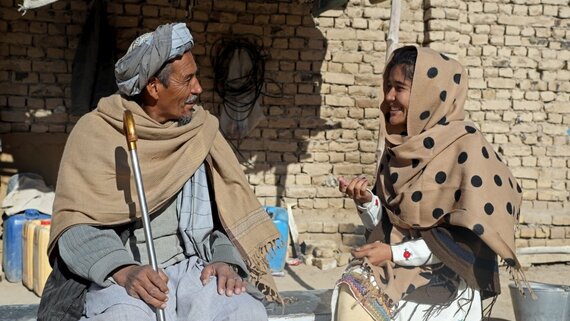
Quetta, Pakistan
This 22-year-old girl is an Afghan refugee in Pakistan. She often struggled to continue her education while also helping to provide for her family, but she has now set up an informal school at her family home for around 50 Afghan children. She explains: "Where I live, many children are deprived of education due to poverty. I saw for myself that some families were reluctant to allow their sons to attend my school, as these little boys were bringing in a bit of money each day by working odd jobs. It was even harder to convince some parents to enrol their daughters in school, given the traditional roles associated with women and girls. There has since been some improvement, but the process of change is always slow. But even with a good education, the life of a refugee is very tough. Our degrees do not necessarily help us to get jobs, and we don’t live with the same sense of freedom that others have. Sometimes taunts and other acts of discrimination make us feel isolated and alienated from the society where we live, and which we were born into."
UNHCR/Humera KarimIn 2022, the situation inside Afghanistan is likely to remain fluid. According to UNDP’s rapid appraisal on Economic instability and uncertainty in Afghanistan after August 15, the country may face universal poverty by mid-2022 and could be on its way to a developmental collapse. An estimated 72 per cent of Afghans are already living below the poverty line, but this percentage is at risk of rising to 97 per cent of the population unless the country’s political and economic crises are urgently addressed. Given this background, borders are likely to remain tightly regulated and movement may take place irregularly, increasing the vulnerability, including to exploitation, of people crossing borders, both during their journey and upon arrival as well as deportation. In neighbouring countries, the difficult situation described above necessitates a scaled-up response from the international community to ensure that the immediate needs of Afghans and their host communities are met, to promote resilience, facilitate solutions and stabilize displaced populations. In accordance with the principle of AAP, communities will be actively engaged in planning, implementing and evaluating the response by soliciting, hearing and acting upon the voices and priorities of women, girls, boys and men, including the most marginalized and at-risk people among affected communities. In addition, measures to prevent, mitigate the risks of and respond to sexual exploitation and abuse will be prioritized and integrated in all sector programmes.
Response priorities in 2022
Reaffirming the regional multi-stakeholder and multisectoral approach that bridges humanitarian and development assistance and builds community resilience, the RRP will deliver concrete actions, with a focus on community-based interventions incorporating an AGD approach, cross-border collaboration, and durable solutions in line with the SSAR and the SSAR Support Platform. The 2022 RRP will aim to:
- Ensure coordinated efforts and support towards durable solutions by enhancing conditions and community-based investments. The response will support the resilience of refugees and host communities, including through investments in key areas of national infrastructure, such as education and health, and by supporting livelihoods for Afghans and host communities, in keeping with the SSAR.
- Support host governments to ensure access to asylum and protection in accordance with international standards, including respect for the principle of non-refoulement, admission, registration and documentation.
- Provide multisectoral humanitarian assistance to targeted populations, anchoring the response in government systems wherever possible in line with the GCR, paying particular attention to the needs of children, youth, women, the elderly, persons with disabilities and other people with specific needs.
- Reinforce government efforts to ensure that emergency preparedness and response measures are put in place to respond to potential new arrivals.
Further reading
Source: UNHCR
Democratic Republic of the Congo Regional
Analysis of the context, crisis and needs
The Democratic Republic of the Congo (DRC) remains one of Africa’s most complex and long-standing humanitarian crises. Ongoing conflicts in eastern DRC, as well as intercommunal violence across different areas of the country, continue to cause forced displacement within DRC and into neighbouring countries. This has come with tragic loss of life, widespread sexual violence against women and girls, protection risks for the most vulnerable, including children and young people, and destruction of communities. The situation is further aggravated by the COVID-19 pandemic, Ebola and measles outbreaks and severe food insecurity. It is compounded by natural disasters including the 2021 volcanic eruption in the east of the country. Within a fragile socioeconomic context, development challenges and continuous instability characterized by serious threats by armed groups, the underlying drivers of displacement and humanitarian need are expected to persist.
During 2021, nearly 962,000 Congolese refugees and asylum-seekers were being hosted across the African continent, with the majority living in the seven neighbouring countries that form part of the inter-agency Regional Refugee Response Plan (RRP) for the DRC Situation: Angola, Burundi, Republic of the Congo, Rwanda, Uganda, the United Republic of Tanzania and Zambia. Asylum-seekers have mostly fled from eastern areas of North and South Kivu and Ituri Provinces, as well as from Kasai, Haut Katanga and Tanganyika Provinces.
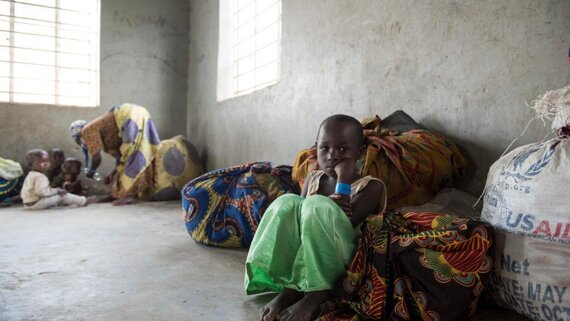
Uganda
Refugees fleeing violence in DRC rest at a reception centre in Uganda. After being received at the centre, refugees are provided with warm food, shelter and safety.
UNHCR/Hannah Maule-FfinchNew Congolese refugees and asylum-seekers require urgent protection and basic assistance, while those in protracted situations – many for decades – remain in need of solutions and humanitarian support. RRP partners promote self-reliance with the aim of reducing dependence on humanitarian assistance, but this process is slow and mostly underfunded. Therefore, most Congolese refugees continue to rely on multisector humanitarian programmes, and there is an urgent need to increase opportunities for complementary humanitarian-development nexus interventions.
In many host countries, refugee settlements and camps have reached or exceeded capacity; the available basic services are stretched to their limit, including those for affected members of host communities. Food insecurity across the region remains a growing concern for refugees and host communities, compounded by food ration cuts in refugee camps and settlements due to underfunding. Where possible, inclusion into national and local basic and social services remains vital to ensure refugees meet their basic needs and have equal access to quality services, as well as livelihood opportunities. Reports continue of incidents of discrimination and xenophobia in some refugee-hosting countries, which highlights the need to intensify work on social cohesion and peaceful coexistence, improve accountability, address prejudice, and include both refugee and local communities in decision-making.
Projected situation in 2022 and beyond
Moving into 2022, it is expected that in addition to ensuring protection for all refugees and asylum-seekers, there remains a need to continue delivering basic services and humanitarian programmes for the surrounding populations, and promoting resilience and linkages with development programmes. Countries in the region have demonstrated commitment to maintaining open borders for asylum-seekers, and Congolese are expected to continue benefiting from safe access to asylum and international protection in 2022. Governments implemented border closures in 2020 and 2021 as a precautionary measure against the spread of COVID-19, but in most cases refugees and asylum-seekers continued to be granted access to territory. In situations where this may not be the case, RRP partners are committed to engaging with governments to ensure asylum-seekers still have safe access to territory.
Some host countries – Uganda being a key example – have adopted policies allowing refugees freedom of movement, and the right to work, establish a business, own property and access national services, including primary and secondary education and health care. Some host countries have also taken active steps to provide refugees with land for agriculture and opportunities to engage in the local economy, while others have pledged to strengthen asylum and enhance refugee protection and solutions. These enabling environments promote resilience and increased self-reliance and serve as good practice for the region.
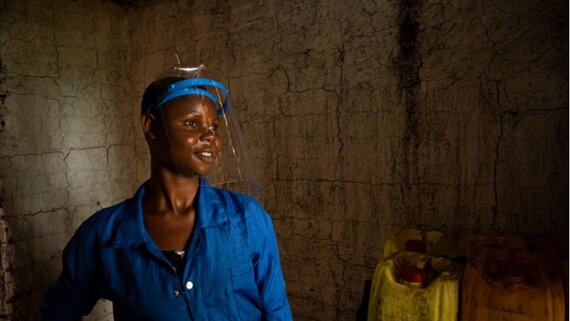
Musasa, Burundi
A refugee woman from DRC, now employed in a soap factory in Musasa refugee camp, in Burundi’s Muyinga Province.
UNHCR/Will SwansonIn contrast, some host countries still impose restrictions on freedom of movement, and the right to work, land and property rights, and access to education and justice. RRP partners will continue to advocate for these restrictions to be lifted and for the adoption of policies in the spirit of the GCR that mirror good practices in the region, such as the Southern African Development Community commitments to improve protection of refugees and asylum-seekers.
With regards to solutions, a modest number of Congolese voluntarily repatriated in 2021, and it is anticipated that others will return in 2022, mainly from Angola and Zambia. Yet, the majority of Congolese refugees are expected to remain in their countries of asylum. Resettlement is a possibility for some, but spaces remain very limited. Therefore, local socioeconomic integration remains the most appropriate solution for most Congolese refugees. Meanwhile, for the majority of Congolese refugees and asylum-seekers still living in camps and settlements, the need for site expansion, improved infrastructure and expanded services in camps and settlements will continue into 2022.
DRC RRP: Evolution of needs and requirements
Response priorities in 2022
In the spirit of the GCR and in line with the Refugee Coordination Model (RCM), host governments will be supported to provide protection and assistance to refugees in their territory and to ensure a comprehensive refugee response. Partners will aim to address the immediate needs of new arrivals, including prevention of expulsion and deportation, and to provide protection and solutions to those in protracted situations. Partners will also seek to assist members of host communities through integrated services, benefiting both refugee and host communities. Particular attention will be paid to identifying and improving opportunities for the most vulnerable, including children, youth and women, as well as for people with specific needs, including those with disabilities.
Protection priorities in 2022 include the prevention and risk mitigation of and response to gender-based violence; strengthening child protection through community-based approaches; registration and documentation support; and prevention of sexual exploitation and abuse. Voluntary repatriation to DRC will be facilitated, where conditions allow. Local integration will continue to be supported where conditions allow, while the cases of people who need resettlement will continue to be processed.

Lóvua, Angola
This woman, known as “Mama Antho,” fled DRC four years ago. She runs an agricultural association with some 30 refugee women from DRC who work on farms in and outside the Lóvua settlement, in Angola’s Lunda Norte Province. She has several rice farms in the host community and is supported by other female farmers who live in the settlement.
UNHCR/Omotola AkindipeSubject to resources available, partners will seek to adhere to minimum standards of assistance, while strengthening approaches that are accountable to affected populations and localized. Support to communities will include maintaining and improving medical services; enhancing nutritional status; addressing food insecurity through in-kind and cash assistance; improving shelter and basic infrastructure; rehabilitating and constructing water and sanitation facilities; and ensuring quality education through training, infrastructure support and basic supplies. Preparedness and response for the COVID-19 pandemic, as well as other health epidemics, will continue to be included in operations and mainstreamed into regular programming.
Partners will seek to mitigate environmental impacts and address clean energy needs by facilitating and promoting the use of energy-saving stoves and alternative fuels, including solar energy where funds allow. Tree-planting will be expanded in the vicinity of camps and settlements alongside awareness-raising initiatives to address environmental degradation and promote peaceful coexistence with host communities.
Humanitarian assistance remains an essential component of the DRC RRP. However, there will be an increased focus on developing sustainable livelihoods opportunities and promoting socioeconomic inclusion in line with the GCR. This will include, but is not limited to, strengthening partnerships with development actors and international financial institutions to ensure a humanitarian-development nexus approach. The aim is to achieve greater impact by responding to immediate needs while at the same time building resilience and self-reliance.
Further reading
Source: UNHCR
South Sudan Regional
Analysis of the context, crisis and needs
2021 marked the tenth anniversary of the independence of South Sudan, and the eighth year of conflict within the country. The security situation, though generally stable, remains fragile in a complex and unpredictable political environment. Peace largely holds at the national level, but subnational violence linked to localized armed conflict and criminality causes death and widespread human rights abuses. Forced displacement numbers are high scale, with 1.7 million IDPs across South Sudan and continued new refugee influxes into DRC, Ethiopia, Kenya, Sudan and Uganda. At the time of writing, this protracted situation remains the largest refugee crisis in Africa, with close to 2.3 million South Sudanese refugees living in the five main neighbouring host countries.
The operational environment remains extremely challenging, with long-standing humanitarian needs compounded by localized violence, severe floods and the COVID-19 pandemic. Growing funding gaps have led to more acute needs, particularly affecting food security, while operational costs have increased due to logistical constraints, such as weak national infrastructure and bureaucratic obstacles. Since the warring parties signed the Revitalized Agreement on the Resolution of the Conflict in the Republic of South Sudan in September 2018, some 300,000 refugees have returned to South Sudan in a self-organized manner from Ethiopia, Kenya, Sudan and Uganda. However, access to essential services remains woefully insufficient, and conditions are not yet conducive to facilitating voluntary repatriation in safety and dignity to South Sudan.
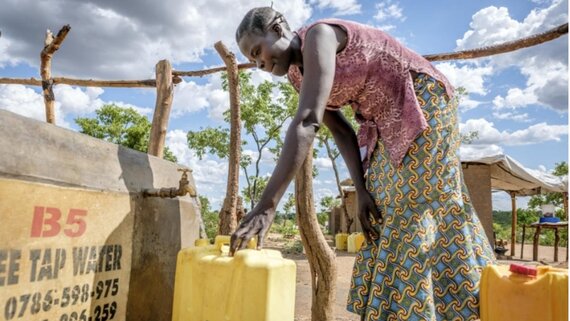
Yumbe, Uganda
A South Sudanese refugee woman collects water at the Bidibidi refugee settlement in northern Uganda’s Yumbe district.
UNHCR/J. OseDespite partial border closures due to the pandemic in 2021, over 130,000 new South Sudanese arrivals have joined refugees from previous waves of forced displacement, in Ethiopia, Sudan and Uganda. Refugees are being generously hosted in countries in the region, but new arrivals have overstretched reception capacities and increased pressures in the main refugee settlements. The increasingly complex regional context due to the COVID-19 pandemic, the outbreak of violence in DRC and Ethiopia, the difficult political and economic situation in Sudan, as well as the stated intention of the Kenyan Government to close its refugee camps by 30 June 2022 pose new challenges for the protection of South Sudanese refugees throughout the region. Launched in October 2020 as a flagship activity of the Intergovernmental Authority on Development (IGAD) Support Platform, and with the support of UNHCR, the Solutions Initiative for Sudan’s and South Sudan’s forcibly displaced is contributing to creating conducive conditions for sustainable and safe voluntary return while preserving protection and asylum space for refugees and returnees, internally displaced persons, and host-community members in the two countries.
Projected situation in 2022 and beyond
In light of current trends, significant numbers of new South Sudanese refugee arrivals are expected in the five asylum countries in 2022. Most South Sudanese refugees are hosted in relatively remote, underdeveloped and economically underserved areas. Host communities often find themselves in a precarious socioeconomic situation, impacted by food insecurity and malnutrition, suffering from limited access to essential services and economic infrastructure, as well as scarce livelihood opportunities. New refugee influxes could further exacerbate the situation for both the refugee and local community populations by increasing competition over limited social services, livelihood opportunities and natural resources, and contributing to social tensions.
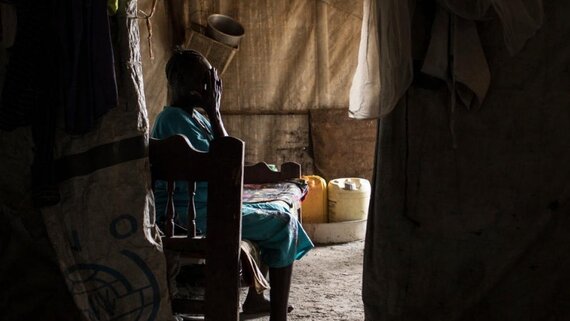
Malakal, South Sudan
This woman's husband attempted suicide months after they arrived at the Malakal Protection of Civilians site. He was rescued by a friend, who, worried about his state of mind, lived with him for a month. Another friend lent him money to start a small carpentry business. He stopped drinking and was reconciled with his wife. His suicide attempt is part of a larger crisis across the country. Mental health experts believe the negative effect of South Sudan’s conflict on civilians’ mental health has been staggering. The horrors of the civil war are just one of many contributing factors. Many people feel rootless and struggle to regain their lost identity, which is magnified by depression and anxiety. Men cannot support their families. Childhood ends early and the future is clouded by uncertainty. Home-made alcohol is easily available, which adds to violence and domestic abuse.
UNHCR/Will SwansonFurthermore, the impact of the ongoing COVID-19 pandemic as well as other health crises, malnutrition, natural disasters and severe resource constraints are likely to further exacerbate the already precarious situation and expose South Sudanese refugees to increased protection risks. Due to the loss of income and livelihood opportunities, prolonged school closures, overcrowded shelters, food insecurity, a lack of domestic energy supply and reduced humanitarian assistance, gender-based violence (GBV) incidents could rise even further. Refugee children (65 per cent of the population) face particular risks, including child labour, abduction, early marriage and irregular onward movement through smuggling and trafficking. The situation of thousands of unaccompanied/separated children is particularly concerning, as many suffer harassment, exploitation, neglect and abuse. These challenges generate increased needs for mental health and psychosocial services, strengthened child-protection systems, enhanced community structures, and reinforced GBV prevention and response mechanisms. There is also an urgent need to develop sustainable energy solutions and prevent environmental degradation.
South Sudan RRP: Evolution of needs and requirements
Response priorities in 2022
The 2022 RRP for South Sudan outlines the multi-agency response strategy and financial requirements of 93 partners, including humanitarian and development actors and civil society, supporting host governments to meet the critical needs of over 2.3 million South Sudanese refugees living across the five main asylum countries. In addition, the plan aims to assist over 1.3 million affected members of host communities.
The inter-agency response plan, developed in accordance with the Refugee Coordination Model, takes a comprehensive and solutions-oriented approach. RRP partners will reinforce the response to meet the life-saving needs of South Sudanese refugees while strengthening national protection and resilience mechanisms in asylum countries. Given the need to move beyond emergency assistance to overcome the socioeconomic impact of the pandemic, strengthen the resilience and self-reliance of South Sudanese refugees and support host communities to enhance peaceful coexistence, the 2022 RRP envisages stronger engagement with development and peacebuilding partners. The IGAD Support Platform, with the pledges made by South Sudan and the five asylum countries, will further contribute to an integrated protection and solutions strategy for South Sudanese refugees.
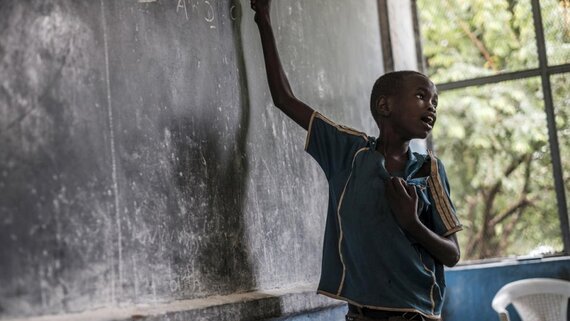
Jewi, Ethiopia
A South Sudanese boy stands at the blackboard at a primary school in Jewi refugee camp, Ethiopia.
UNHCR/Eduardo Soteras JalilIn line with the Global Compact on Refugees, RRP partners plan to advance refugee integration into national systems, such as education, health, environment, livelihoods, child protection and birth registration. A key priority in 2022 will be promoting socioeconomic inclusion and access to livelihoods opportunities for urban and camp-based refugees, and addressing chronic food insecurity, including by increased agropastoral production. RRP partners will prioritize innovative approaches, expand cash-based interventions to increase refugees’ self-reliance, and integrate the refugee response into development plans and initiatives to promote socioeconomic growth. Interventions are also foreseen to ensure sustainable energy and prevent/reverse environmental degradation in refugee settings to the benefit of the larger community.
RRP partners will continue to support national child protection systems, including birth registration, prioritize family reunification and alternative care placement and enhance access to quality education. RRP partners will also intensify measures for the prevention of sexual exploitation and abuse and GBV prevention and response; prioritize support to people with specific needs, including those living with disabilities; consolidate community-based protection mechanisms; and scale up psychosocial and mental health support. Activities to strengthen the empowerment of communities and accountability towards affected populations are core elements of the regional refugee response. The RRP will also facilitate refugees’ participation in peacebuilding initiatives, promoting social cohesion between refugee and host communities and national reconciliation efforts in South Sudan.
Further reading
Source: UNHCR
Source: UNHCR
Syria Regional
Analysis of the context, crisis and needs
The Syrian refugee situation continues to drive one of the world’s largest humanitarian and development crises. Egypt, Iraq, Jordan, Lebanon and Turkey continue to collectively host over 5.6 million registered Syrian refugees. In addition to Syrians, these countries also host hundreds of thousands of refugees of other nationalities, asylum-seekers, and Stateless persons. Many of these people have been in displacement for a decade or more, are living in high levels of poverty, and have survived because of the continued generosity of host governments and local communities, supported by the international community.
In addition to hosting large-scale refugee populations, the 3RP countries continue to be significantly impacted by the COVID-19 pandemic and its multiple waves, as well as associated socioeconomic challenges, some of which pre-date the pandemic. At the macro level, economic forecasts for 3RP countries suggest a long period of recovery and slower growth compared to previous years, which has affected the availability of resources to ensure the provision of basic services, such as health and education. At the household level, poverty and unemployment rates remain extremely high, and the overall average household income across the region has decreased sharply compared to previous years. Among refugees particularly, many children remain out of school across the region and face considerable protection risks. Furthermore, this overall situation sharpened inequalities and impacted social cohesion and stability between refugees and host communities.

Beirut, Lebanon
Hala, a 35-year-old Syrian refugee, combs her youngest daughter’s hair at their home in Beirut. Her family of six all sleep together in a single damp room, the air heavy with the smell of mold that stains the walls and furniture. Hala describes the downward spiral their lives have taken since fleeing the conflict in their home country and coming to Lebanon 10 years ago. “Our main objective was to get out of the war with our lives,” she said of their escape from their hometown of Hama in 2011. “In Lebanon there was a little bit of serenity. Our kids were still going to school, they were learning, they would become something in the future and make their mother and father proud.” But Lebanon’s financial crisis has sent the currency plummeting and prices of everyday basics rising. Combined with the devastating economic effects of the pandemic, the number of Syrian refugees in Lebanon living under the extreme poverty line increased to almost 90 per cent by the end of 2020. “It’s like we’re living a daily war; a silent, domestic war,” said Hala.
UNHCR/Haidar DarwishThe 3RP 2022 Regional Needs Overview provides a comprehensive overview of needs in 3RP countries. In addition to the needs of the large-scale refugee populations, the number of impacted host-community members has now reached the highest figure in a decade. Protection-related intersectoral needs, particularly those related to legal status, gender, age and people with special needs, have been highlighted across regional assessments. The need for broader availability and improved access to quality education, livelihoods opportunities, and quality food and health care are all essential. Enhancing local capacities, specifically in improving basic service provision and expanding social safety net programmes inclusive of all vulnerable people, is necessary to ensure the sustainability and efficiency of the response. And given the protracted nature of their displacement, there must be an increased focus on durable solutions for Syrian refugees.
Projected situation in 2022 and beyond
Given the continued impacts of the COVID-19 pandemic, tough socioeconomic conditions and other compounding crises, it is anticipated that the large rise in needs among refugees and host-community members across the 3RP countries will be sustained and may worsen in some countries. Many people have already lost their livelihoods and have been pushed further into poverty and food insecurity, with the most vulnerable remaining in day-to-day survival mode.
Access to quality basic health and education services will remain challenged. Female-headed households will continue to be more vulnerable in terms of livelihoods, income, food security and violence. Protection risks, such as gender-based violence (GBV), sexual abuse and exploitation, domestic violence, forced and child marriage and child labour may increase in some countries. And social cohesion and stability between refugees and host communities could be further challenged by political and socioeconomic factors in some countries.
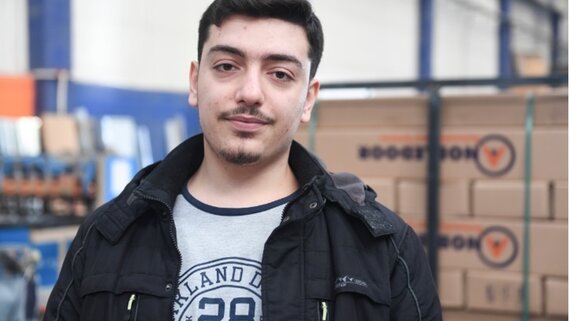
Gaziantep, Turkey
“One day I saw an advertisement on social media and that changed my life,” says this 23-year-old Syrian living in Gaziantep, Turkey. He now works in foreign trade for a local elevator manufacturer that also exports to EU markets and the Middle East. He has been working at the company for eight months while pursuing his studies in his final year at Gaziantep University’s International Trade and Logistics Department. “I have clients from 10 countries, and I am trying to help my company expand to other markets as well.”
UNDP/Levent KuluAgainst this backdrop of rising needs, funding trends for the 3RP are declining in real terms, impacting the ability of 3RP actors to meet the most urgent needs as well as invest in the resilience of local communities and institutions who deliver basic services to all. The 3RP witnessed a reduction of some US$350 million in the first half of 2021, and cuts in assistance have been adopted in some countries. With host countries’ resources being stretched to their limits – a situation that will likely continue in the coming year – as well as the difficult global funding environment, ensuring financial support to host countries and to the 3RP remains a top priority.
Syria 3RP
Response priorities in 2022
In support of governments’ ongoing efforts, over 270 partners across the five 3RP countries will continue to assist refugees and other vulnerable populations as well as impacted members of their host communities in 2022. This includes, where possible, taking into consideration the needs of all persons of concern, Syrian and non-Syrian alike, including asylum-seekers and Stateless of other nationalities, in the spirit of the Global Compact on Refugees (GCR) and the ‘One Refugee’ approach.
Working within a network of partnerships at the regional, national and local levels spanning intergovernmental organizations, government agencies, NGOs, civil-society organizations, international financial institutions and the private sector, 3RP actors will also continue to strengthen the capacity of public institutions to provide access to quality basic services, in line with the GCR and the 2030 Agenda for Sustainable Development. These initiatives will further support resilience-building for all and contribute to strengthening national public institutions’ response capacities, as well as ensure that no one is left behind.
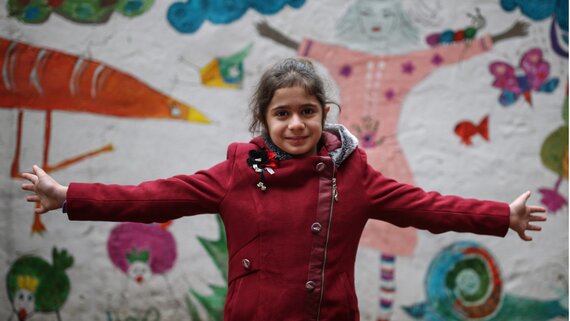
Istanbul, Turkey
After 10 years of displacement, life is no easier for Syrian refugees, including for this 13-year-old refugee girl who lives in Istanbul, Turkey, with her family. They fled Syria five years ago. She has several brothers and sisters, and she is in fourth grade.
UNHCR/Emrah GurelIn particular, the 3RP response priorities in 2022 will aim to make progress in the following four areas:
Protecting people: The protection of people will continue to be at the centre of the 3RP response to ensure no one is left behind. Key programmes and activities in this area will include support for access to territory and asylum and basic rights for refugees, while preventing and reducing statelessness through legally recognized documentation and favourable legal provision. Furthermore, efforts to prevent GBV will be strengthened along with mitigating the risk of its occurrence. Child protection services will be expanded as well as efforts to nurture community protection and refugee and host-community cohesion, while protection from sexual exploitation and abuse (PSEA) will continue to reinforce awareness and trainings on addressing SEA.
Promoting durable solutions: Refugees continue to require access to territory, international protection and support in countries of asylum. Given the protracted situation, opportunities for durable solutions are urgently needed to enable refugees to look to the future with hope and dignity. Key programmes and activities in this area include resettlement and complementary pathways, support for people who take a voluntary and informed decision to return to Syria, as well as promoting local opportunities.
Contributing to dignified lives: As the crisis continues to impact protection and the socioeconomic well-being of vulnerable populations, supporting enabling conditions and opportunities for all to lead a dignified life is a priority for all partners across a range of sectors. To allow families to meet their basic needs, the 3RP will respond in a multisectoral manner (education, health and multipurpose cash assistance), which includes advocating for the inclusion of refugees in social protection programmes. Moreover, efforts will continue towards economic and employability opportunities for refugees and host communities alike while ensuring minimum standards of living for the most affected communities.
Enhancing local and national capacities: Enhancing local and national capacities across the region will remain one of the top priorities of the 3RP – broadening the capacity of national and local institutions and systems to provide protection and essential services.
The 3RP and Lebanon Crisis Response Plan (LCRP)
The unprecedented multi-layered political, economic and public health crises currently facing Lebanon are undermining the subsistence capacity of already vulnerable refugees and host communities across the country, in particular for women, girls and boys. Individuals and families are falling deeper into poverty due to currency depreciation, high inflation, rising food prices and loss of income. The COVID-19 outbreak has exacerbated the situation by reducing vulnerable populations’ access to food, livelihood opportunities and other basic services. The 2021 Vulnerability Assessment for Syrian Refugees (VASyR) revealed that nine out of ten refugees continue to live below the extreme poverty line with increasingly negative consequences, including a rise in child labour and incidences of gender-based violence and a drop in individuals accessing legal residency. Threats of evictions are on the rise as families are increasingly unable to pay rent.
Gaps in supply chains (including fuel and electricity) are impacting the operational environment, including access to services for beneficiaries. LCRP partners are facing increased pressure from local authorities and communities amid spiraling needs. Refugee-host community relations in Lebanon are on an increasingly negative trajectory. In August 2021, through the regular UNDP-ARK perception surveys, 36 per cent of respondents reported negative inter-communal relations compared to 21 per cent of respondents reporting negative inter-communal relations in July 2018. Relationships are becoming increasingly strained, with pressure points ranging from access to services and job competition, to historical grievances between the communities.
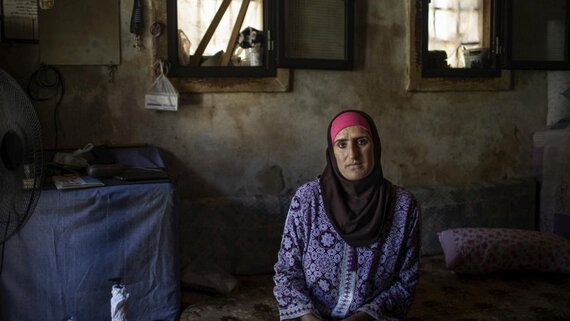
Tripoli, Lebanon
A Syrian refugee from Homs lives in Tripoli’s economically challenged Bab al-Tabbaneh neighbourhood. Syrian refugees in Lebanon struggle to survive amid the worst socioeconomic crisis in decades. Finding a dignified and safe shelter continues to be a struggle, with almost 60 per cent of Syrian refugee families living in dangerous, substandard or overcrowded shelters.
UNHCR/TripoliThe situation in Lebanon continues to look bleak for refugees and host communities in 2022. Delays to government-led social safety nets schemes mean that many Lebanese families will not imminently receive the assistance they have been waiting for. State institutional capacity has been significantly impacted by the compounded crises, with a real risk of health, education and social institutions being unable to provide services. Municipalities that have long been at the forefront of responding to the Syria crisis now face gaps in their ability both to provide services and respond to localized emergencies, given insufficient resources and supply gaps.
In 2022, the LCRP’s dual focus on refugees and host communities and the nexus approach will be even more critical to contributing to reducing the tensions and preserving protection space. The LCRP will target 1.5 million Syrian refugees, 207,700 Palestine refugees and 1.5 million Lebanese. The plan will retain a focus on strengthening protection for vulnerable people, including through the provision of legal services and case management for specific groups such as people with disabilities, GBV survivors and children at risk. Ensuring access to basic services, including education and health as well as water and shelter, will continue to be prioritized through interventions that seek to meet needs across the country.
Economically vulnerable refugees and host communities will continue to be supported with cash-based assistance and access to dignified work, ensuring a harmonization of transfer values and currencies of disbursement across sectors, in order to mitigate tensions and protection risks. Support to small- and medium-sized businesses, municipalities and other local entities including social development centres, primary healthcare centres and water establishments will remain a key component of the LCRP’s support to host communities, with approaches designed to contribute to social stability in Lebanon.
Further reading
Source: UNHCR
Source: UNHCR
References
- UNHCR - The Global Compact on Refugees
- SSAR Support Platform
- UNDP Press release - "97 percent of Afghans could plunge into poverty by mid 2022, says UNDP", September 9, 2021.
- UNHCR Operational Data Portal - DRC Situation
- Refugee Coordination Model - Updated Refugee Coordination Guidance Note
- Intergovernmental Authority on Development (IGAD) Support Platform Press release - December 16, 2019.
- UNHCR Press release - "Joint Statement by IGAD, UNHCR and the governments of South Sudan and Sudan on the Solutions Initiative for 7 million forcibly displaced people", October 5, 2021.
- Refugee Coordination Model - Updated Refugee Coordination Guidance Note.
- Intergovernmental Authority on Development (IGAD) Support Platform Press release - December 16, 2019.
- UNHCR - The Global Compact on Refugees
- Regional Refugee & Resilience Plan - Regional Needs Overview, 2022.
- UNHCR - The Global Compact on Refugees
- United Nations - The 2030 Agenda for Sustainable Development
- United Nations - "Universal Values: Principle Two: Leave No One Behind"

